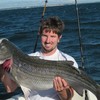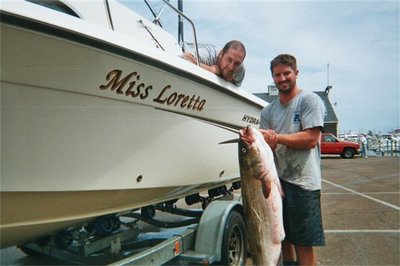This article originally appeared in the Sports section of Barnstable-Hyannis Patch.
http://barnstable-hyannis.patch.com/articles/a-new-perspective-on-scorton-ledge
Scorton Ledge is one of the most well known fishing locations on the Cape. Almost everyone who wets a line in Cape Cod Bay has at least heard of the Ledge.
This past weekend, the Ledge coughed up another 50 pound bass to one fortunate angler. Again it is no surprise the massive striper was caught on a red tube and worm.
Odds are that 50 pound fish will be the first of many trophy bass taken from the Ledge this season.
Most Cape Cod fishermen know the Ledge produces big bass. However there are many questions as to the reason behind Scorton's phenomenal fishing.
Why is it such a productive area? Why do red tubes work so well? Why do bass stack up on the Ledge during the late summer and early fall?
The list of unanswered questions continues.
Yet for anglers serious about making the most of their fishing time on Cape Cod Bay, an understanding of the Ledge is critical.
Scorton Ledge in a Nutshell
From what I have been told by divers, the Ledge is actually more of a hump. On a full moon low tide, the depth on top of the Ledge may be a mere 10 feet. To the east and west of the Ledge, the depth gradually falls off to around 40 feet.
My unscientific opinion is that the Ledge was formed by glacial activity, like many of the kettle ponds here on Cape Cod.
From the information I have gathered, the Ledge consists of a muddy bottom and is strewn with large boulders. I remember marking one boulder on my sonar that rose more than 10 feet from the bottom. This particular boulder was located on the eastern side of the hump, however many smaller boulders litter the area.
This is prime sea bass and lobster territory, and during the height of the summer, the Ledge is bombarded by lobster pots. The lobster pots and drastic depth changes can make it difficult for virgin Scorton anglers to effectively fish the area.
Adding to the challenge is the flotilla of boats that invade Scorton when the bite is on.
Bass Behavior on the Ledge
The trick to beating the fleet to the bite lies in an angler's ability to predict when the bass will appear on the Ledge.
From my experience, spring-time fishing at Scorton is more consistent than during the summer and fall. In May and June, we often have the luxury of picking up a few nice fish at the Ledge before moving on to more productive areas. Then on the way back to the docks we will troll through the Ledge again, and maybe pick up a bonus fish before calling it a trip.
However this luxury fades as summer approaches. Last summer we did not catch a single bass on the Ledge during the month of July. More often than not the schools of bass remained spread out amongst the deeper waters of the Bay.
Yet as summer wanes, something special occurs at the Ledge.
During late August and September, large schools of stripers have a tendency to "stack up" on the Ledge. This usually occurs after three or four days of a brisk northwest wind.
There are a lot of theories floating around as to why this happens. Many believe bait gets "blown" onto the Ledge, where it congregates and attracts huge amounts of stripers. Others believe it has something to do with bait being flushed out of Scorton Creek-which is located just to the south of the Ledge.
I believe bass congregate at the Ledge for a much different reason-to feed on the plethora of sandworms that call the Ledge home.
Why Bass Stack up on the Ledge
Sandworms are a staple part of a sea bass' diet (not to be confused with striped bass). Throughout the season, the Ledge is often covered by sea bass. These small fish make quick work of a worm on the tail end of a tube and worm rig, if the rig is trolled too close to the bottom.
Because sandworms are a staple part of a sea bass' diet, the presence of so many sea bass on the Ledge indicates there is a strong possibility that the Ledge is also home to thousands of sandworms.
Sandworms are most commonly found in muddy sediment where they feed on algae, shrimp, and clams. Scorton Ledge's muddy bottom is therefore perfect habitat for sandworms.
This would help to explain why red tube and worm rigs work so well at Scorton Ledge. Sandworms can grow to be as long as four feet and are often red or orange in color. It is no coincidence that most bass caught at the Ledge are taken on tubes.
I believe striped bass mistake tubes for large worms.
Bass become more frequent visitors to the Ledge during the late summer and early fall because of a change striped bass behavior and wind patterns.
As the summer wanes, big bass have a greater tendency to move shallow. During late August and September, bass are more often found closer to the beach than during July. Scorton Ledge is less than a mile from East Sandwich beach, classifying it as a "close to shore" area.
This tendency, coupled with the strong northwesterly winds that accompany late summer and early fall on the Cape draw bass to the Ledge. Three or four days of a strong northwest wind will "kick up" the Ledge's muddy bottom. The constant pounding of waves and currents over the Ledge disturbs the sandworms that are usually hunkered down in the sediment, making them more vulnerable to attack by large stripers.
Spawning Sandworms at Scorton Ledge
It is my understanding that sandworms usually spawn during the spring, however I am not going to disregard the possibility that a spawn also occurs on the Ledge late in the summer-around the same time that Cape Cod experiences brisk northwest winds.
Tim Sheehan is a marine biologist, and president of Gulf of Maine Inc. According to Sheehan, mature male and female sandworms leave their muddy boroughs when spawning. Multiple male worms swim through the water column in pursuit of a female sandworm, hoping for the chance to reproduce.
Worm spawns can occur on an enormous scale, with thousands of worms participating in a single spawn.
If sandworms are spawning around the same time that a brisk northwest wind hits during late summer, it could help to explain why such enormous schools of bass flock to the Ledge, when just days prior not a single bass could be seen in the area.
It could also help to explain why bass stacked up on Scorton Ledge willingly attack a tube and worm rig, while completely disregarding other methods.




